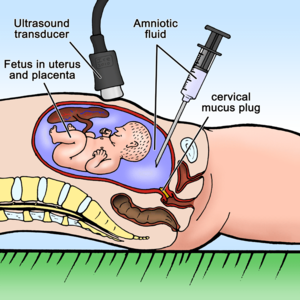Prenatal Diagnosis of Chromosome Abnormalities
Congenital chromosomal aberrations are diseases caused by changing the number of chromosomes (genomic abnormalities) or changing the structure of the chromosome (chromosome abnormalities). Congenital means that they are present in all cells of the body and can be transferred between generations. They are also called as gametic. Estimates of incidence is 5-8 cases per 1000 births.
Typical Chromosomal Aberrations[edit | edit source]
- numerical aberrations of autosomes: Down syndrome (trisomy 21), Edwards syndrome (trisomy 18), Patau syndrome (trisomy 13).
- numerical aberrations of gonosomes: Turner syndrome (45,X), Klinefelter syndrome (47,XXY) syndrome 47,XXX or syndrome 47,XYY
Methods of Prenatal Screening and Diagnosis[edit | edit source]
Very high number of chromosomal variations affects the mental and intellectual development of individuals. This is the reason why the prenatal detection has such a significant role. The capture began already in the 60th years with amniocentesis and only 10 years later Choriocentesis started to be used. In the more recent years approaches to less invasive testing e.g. determination of human alpha-fetoprotein (AFP), hCG or estradiol levels (PAPP-A) were focused on. Increasingly important role also has a detailed ultrasound, focusing on specific markers of chromosomal aberrations along with cytogenetic examinations.
Comprehensive advice and suggestions to investigation process are being addressed through genetic consultation. Advising and inform future parents about possible risk of chromosome abnormalities
Risk Factors and Warning Signs[edit | edit source]
- abnormal screening - ultrasound, biochemistry
- pregnancy at an older age (in many countries, the 35th year of age is considered to be the treshold and indication for detailed diagnostics)
- infectious and noninfectious diseases of pregnant
- medication or exposure to chemicals
- parental couples with a positive family history
- repeated spontaneous abortions
- reproduction failure
Prevention[edit | edit source]
Prevention of congenital chromosomal abnormalities is very difficult. Often it is a genetic disease in which chromosomes are inherited from our parents. Outside influences are not as important however caution is recommended, such as increased intake of folic acid in pregnant women. It is active mainly against the development of neural tube disorders (NTD).
More significant is screening of parents. The examination is performed on blood samples using cytogenetic testing (secondary prevention). Especially in women over 35 years of age the risk is becoming to be significantly higher. Primary prevention is to minimize exposure to potentially pathogenic factors at work - biological, chemical, physical.


